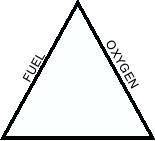
CHAPTER 4
FIRE-FIGHTING FUNDAMENTALS
Ships' Technical Manual (NSTM), chapter 555,
Learning Objective: Recall the components of the
volume 1.
"fire triangle," the classifications of fires, the
fundamentals of extinguishing fires, and the different
HEAT
extinguishing agents used.
Fire is a constant potential hazard aboard ship.
You must take all possible measures to prevent fires
f r o m s t a r t i n g . I f a fi r e d o e s s t a r t , y o u m u s t
immediately report the fire to the officer of the deck
and then extinguish it rapidly. Often a fire will start in
conjunction with other damage caused by enemy
action, storms, or an accident. A fire can cause more
HEAT
damage than the initial casualty if not immediately
DCf0401
extinguished. In fact, a fire could cause the loss of a
Figure 4-1. The fire triangle.
ship even after the original damage has been repaired
or minimized. A Damage Controlman has to know
Fire is also called combustion. Combustion is a
how to identify the different classes of fires, how to
rapid chemical reaction that releases energy in the form
extinguish them, and how to use and maintain fire
of light and noticeable heat. Most combustion involves
fighting systems and equipment. The more you learn,
rapid OXIDATION, which is the chemical reaction by
the more you will be able to contribute to the safety of
which oxygen combines chemically with the elements
your ship effectively.
of the burning substance. Even when oxidation
This chapter covers the fundamentals of fire
proceeds slowly, such as a piece of iron rusting, a small
fighting. These fundamentals include the components
amount of heat is generated. However, this heat usually
of fire, classification of fires, the effects of fire, the
dissipates before there is any noticeable rise in the
f u n d a m e n t a l s o f ex t i n g u i s h i n g fi r e s , a n d t h e
temperature of the material being oxidized.
extinguishing agents used.
With certain types of materials, slow oxidation can
turn into fast oxidation if heat is not dissipated. This
FIRE COMPONENTS
phenomenon is known as "spontaneous combustion"
and results in a fire. Therefore, materials identified as
Learning Objective: Recall the components of the
subject to spontaneous combustion are normally stowed
"fire triangle."
in a confined space where the heat can be dissipated
Three components are required for a fire. They
rapidly. Materials, such as rags or papers that are soaked
are a combustible material, a sufficiently high
with animal fat, vegetable fats, paints, or solvents, are
temperature, and a supply of oxygen. Known as the
particularly subject to spontaneous combustion.
"fire triangle" (fig. 4-1), these three components are
For a combustible fuel or substance to catch on fire,
simply referred to as follows:
it must have an ignition source and be hot enough to
Heat
burn. The lowest temperature at which a flammable
substance gives off vapors that will burn when a flame or
Fuel
spark is applied is known as the FLASH POINT. The
temperature at which a fuel will continue to burn after it
Oxygen
has been ignited is known as the FIRE POINT. The fire
point is usually a few degrees higher than the flash point.
Fires are generally controlled and extinguished
The AUTO-IGNITION or SELF-IGNITION POINT is
by eliminating one side of the fire triangle; that is, if
the lowest temperature to which a substance must be
you remove either the fuel, heat, or oxygen, you can
heated to give off vapors that will burn without the
prevent or extinguish a fire. For more details on
application of a spark or flame. In other words, the
flaming combustion requirements, refer to Naval
4-1

